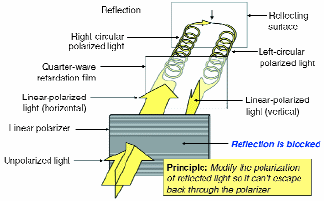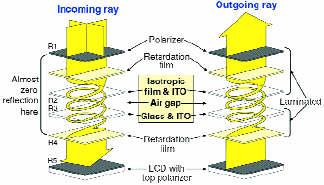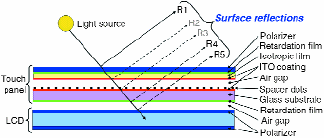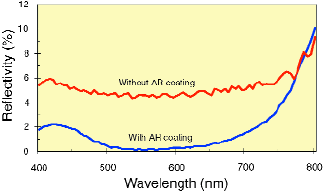|
Analog Resistive Touch Panels and Sunlight Readability
Several methods to improve the sunlight readability of touch-enabled LCD screens are explored, with emphasis on minimizing cost and weight.
by John W. Stetson
ANALOG RESISTIVE touch panels are by far the most commonly used touch interface on mobile devices. The reasons are clear: low cost, low power consumption, thin structure, narrow edge margin, availability in small sizes, finger or stylus input, and myriad suppliers. But the picture is not all rosy. Mobile resistive touch panels have problems with sunlight readability, UV degradation, durability, operating temperature range, shock and vibration, and lifetime. This article focuses on solutions to the sunlight-readability problem.
There are three basic methods of achieving sunlight readability in displays:
• By actively increasing the backlight intensity by adding more cold-cathode-fluorescent-lamp (CCFL) backlight tubes. This method is commonly used to achieve sunlight readability in fixed-location applications. Unfortunately, this method is impractical in most mobile-device applications because of power-consumption (battery life), thickness, heat, and weight considerations.
•
|
By passively increasing the backlight intensity by adding brightness-enhancement films to the optical stack of the liquid-crystal display (LCD). Although this method avoids all of the inherent issues of the active approach, the achievable brightness increase is limited to about 2x, which is insufficient for solving the sunlight-readability problem.
• By controling reflections to maintain contrast. Reflected light is the real problem, so controlling the reflections is the most effective method of achieving sunlight readability. However, due to the relatively limited light output of most mobile-device LCDs, this method is often combined with passive backlight enhancement.
Reflections: The Real Problem
As shown in Fig. 1, a resistive touch panel has four surfaces that reflect light back to the user (R1 through R4). A surface reflects light when there is a difference in the refractive index of the material versus air. In a touch panel that is not enhanced, the amount of incident light reflected by each surface (R1 through R4) is approximately 4% + 7% + 7% + 4%, totaling about 22%. The surface of the LCD (R5 in Fig. 1) also reflects about 4% of the light, for a grand total of about 26%. If the touch panel is being used in ambient light of 30,000 lux (moderate sunlight), the amount of light reflected back to the user is about 2500 cd/m2, which is as much as an order of magnitude greater than the amount of light typically emitted by the LCD. The result is that the effective contrast ratio of the LCD is reduced to very close to 1.0, making the LCD unreadable.
There are only two practical methods of controlling reflections in a resistive touch panel: the use of either anti-reflection coatings or a circular polarizer with retardation films. The two methods can also be combined to maximize the effect.
John W. Stetson is Regional Sales Manager for Gunze U.S.A., 2113 Wells Branch Parkway, Bldg. 5400, Austin, TX 78728; telephone 512/990-3400 x126, fax 512/252-1181, e-mail: jstetson@gunzeusa.com.

Fig. 1: Resistive-touch-panel construction showing surface reflections.
Anti-Reflection Coatings
At its simplest, an anti-reflection (AR) coating is a thin layer of material with an index of refraction that is the geometric mean of the two surrounding indices. This optimum index of refraction maximizes the transmission of light into both the thin layer and the substrate, which in turn results in minimum reflection. Because the purpose of the thin layer is to compensate for the difference in refractive indices, AR coatings are often called "index-matching" coatings.
AR coatings also take advantage of another effect of thin layers, i.e., optical interference. If the thickness of the thin layer is exactly one-quarter (or an odd multiple of one-quarter) of the wavelength of the light, then the light reflected from the substrate travels exactly half its own wavelength further than the light reflected from the surface of the thin layer. If the intensities of the two out-of-phase reflections are equal, they destructively interfere and cancel each other, producing no reflection from either surface – at least, for the target wavelength. For this reason, AR coatings are also often called "quarter-wavelength" coatings.
AR coatings in the real world are typically made of multiple layers of high- and low-index-of-reflection materials of varying thicknesses. The thickness of each layer is determined not only by the quarter-wavelength effect, but also by leveraging the fact that the speed of light through the layer depends on its wavelength. By carefully selecting the number of layers, the materials, and their thicknesses, broadband AR coatings on glass, which reduce the reflectivity to 0.2–0.5% across the visible spectrum, can be achieved.
Anti-Reflection Coatings for ITO
However, reducing reflections from indium tin oxide (ITO) on polyethylene terephthalate (PET) is a more difficult challenge for several reasons. First, the refractive index of ITO is 2.0, which produces a reflectivity of more than 7%. Second, the number of index-matching layers that can be deposited on PET (including the ITO) is generally limited to three, due to the internal stress on the ITO. That means the layer stack is limited to one high-index layer, one low-index layer, and the ITO. Industry standards for the high- and low-index layers are TiO2 and SiO2, respectively. The combination of the TiO2, SiO2, and ITO layers typically produces a reflectivity of 4% from the ITO-on-PET surface.
Reducing the reflections from ITO on glass is easier because additional index-matching layers can be used to reduce reflections. Starting with a barrier layer of pure SiO2 on the glass (to prevent sodium ions from escaping from the glass), and using multiple high-, medium-, and low-index layers on top of that, reflections from the ITO-on-glass surface can be reduced to 1%. Table 1 summarizes the reduction in touch-panel reflections that can be achieved using AR coatings.
Circular Polarizer with Retardation Film
The use of a circular polarizer to eliminate internal reflections in a resistive touch panel is complementary to the use of anti-reflection coatings. A circular polarizer is created by combining a linear polarizer with a quarter-wave retardation film. Figure 2 illustrates the principle of how a circular polarizer can be used to eliminate reflections. Unpolarized light passes through a linear polarizer and becomes polarized in the direction of the polarizer's axis (shown as horizontal in Fig. 2). The light then passes through a quarter-wave phase retardation film and becomes right-circularly polarized. Circularly polarized light changes orientation when it bounces off a surface, so the reflected light becomes left-circularly polarized. When the light passes through the quarter-wave film again, it reverts to linear polarization, but this time orthogonal to the original direction of polarization. The linear polarizer therefore blocks the reflected light. In Fig. 2, the linear polarizer and retardation film are shown separately for clarity; in actuality, they are laminated together to form a circular polarizer.
Table 1: Reduction in Touch-Panel Reflection by Using AR Coatings
| |
|
|
|
|
Total
|
|
Total
|
|
| |
R1
|
R2
|
R3
|
R4
|
Touch
|
R5
|
Touch + LCD
|
| |
(%)
|
(%)
|
(%)
|
(%)
|
(%)
|
(%)
|
(%)
|
| No Enhancement |
4
|
7
|
7
|
4
|
22
|
4
|
26
|
| Five AR Coatings |
0.5
|
4
|
1
|
0.5
|
6
|
0.5
|
6.5
|

Fig. 2: An illustration of how a circular polarizer can be used to eliminate reflections. Note: The linear polarizer and retardation film are shown separately for clarity; in actuality, they are laminated together, forming a circular polarizer.
Figure 3 illustrates the application of a circular polarizer and retardation film to a resistive touch panel. Note that although they are shown separately for clarity, the polarizer, upper retardation film, and isotropic film are laminated together, as are the glass and the lower retardation film. From the perspective of an incoming light ray, reflection R1 is unchanged at 4%. If the polarizer was 100% effective, and if the quarter-wave retardation films produced exactly a 90° phase shift over the full visible range of wavelengths, then the reflections from the internal surfaces of the touch panel (R2 and R3) would be zero. However, neither of these conditions is actually true, so there is about 0.5% reflectivity from R2 and R3 combined, which reduces to 0.2% after going back through the polarizer. Reflections R4 and R5 would normally be 4% each, but after going back through the polarizer they are about 1.6% each. Total reflection from the touch panel and LCD together is therefore about 7.4%, as shown in Table 2. Note that the linear retardation film has no function in reducing reflections from incoming rays; it is only associated with outgoing rays.
From the perspective of an outgoing light ray, the linearly polarized light emitted by the LCD is converted to circular polarization by the lower retardation film and then back to linear by the upper retardation film so that it can pass through the top polarizer. The only purpose of the lower retardation film is to counteract the effect of the upper retardation film; without it the upper retardation film would convert the lineraly polarized light emitted by the LCD into the circularly polarized light which would be blocked by the top polarizer. In order to minimize the light loss, the absorption axis of the touch panel's polarizer must be closely matched to the absorption axis of the LCD's top polarizer. In the real world of LCD applications, this means that a circular-polarizer touch panel is typically designed and manufactured to match a specific LCD. If the product in which the touch panel is being used supports multiple LCDs (different resolutions or even just second-source LCD vendors), either the additional LCD vendors must be convinced to supply LCDs with a specified polarizer absorption axis or different touch panels must be manufactured to match each individual LCD. This can result in somewhat of a hidden cost in the circular-polarizer touch-panel solution.
Combining AR Coatings and a Circular Polarizer
The 6.5% reflectivity that is achievable with five AR coatings (Table 1) is similar in magnitude to the 7.4% achievable with a circular polarizer. However, neither one provides enough reflectivity reduction for acceptable sunlight readability. The first step in further reducing the reflectivity is to AR-coat the top surface of the touch panel, reducing its reflectivity (R1) to 0.5%.
There are two possible methods of reducing the remaining reflections (R4 and R5), both of which produce roughly the same reflectivity. The bottom of the lower retardation film and the top surface of the LCD can be AR-coated, which reduces the sum of their combined reflection to about 0.4% after going back through the polarizer. Alternatively, the touch panel can be optically bonded to the LCD. Optical bonding is the process of using an optical adhesive with an appropriate index of refraction to bond the two assemblies together. The resulting reflectivity from two bonded surfaces is typically less than 0.3%, which becomes less than 0.2% after going back through the polarizer. Total reflection from either method is therefore in the range of 0.9–1.1% as shown in Table 2. Figure 4 shows the construction of a circular-polarizer touch panel.

Fig. 3: The application of a circular polarizer and retardation film to a resistive touch panel. Note: Although they are shown separately for clarity, the polarizer, upper retardation film, and isotropic film are laminated together, as are the glass and the lower retardation film.
Table 2: Reduction in Touch-Panel Reflections by Using a Circular Polarizer and AR Coatings
| |
|
|
|
|
Total
|
|
Total
|
|
| |
R1
|
R2
|
R3
|
R4
|
Touch
|
R5
|
Touch + LCD
|
| |
(%)
|
(%)
|
(%)
|
(%)
|
(%)
|
(%)
|
(%)
|
| No Enhancement |
4
|
7
|
7
|
4
|
22
|
4
|
26
|
| Circular Polarizer |
4
|
0.1
|
0.1
|
1.6
|
5.8
|
1.6
|
7.4
|
| Circular Polarizer with Three AR |
0.5
|
0.1
|
0.1
|
0.2
|
0.9
|
0.2
|
1.1
|
| Coatings (R1, R4, and R5) |
|
|
|
|
|
|
|
| Circular Polarizer with one AR |
0.5
|
0.1
|
0.1
|
0.1
|
0.8
|
0.1
|
0.9
|
| Coating (R1) and Optical Bonding |
|
|
|
|
|
|
|
|
A total reflectivity in the range of 1% (100 cd/m2 in 10,000 cd/m2 ambient) is sufficiently low to enable adequate sunlight readability. A useful rule of thumb for approximating the effective contrast ratio (CR) in this situation is CR = 1 + (display brightness / reflected light). Assuming that an initial transmissive LCD brightness of 200 cd/m2 was passively enhanced to 300 cd/m2, the approximate effective contrast ratio for a reflectivity of 1% is 4.0, which is adequate although not ideal.
Film–Film Touch Panels with Circular Polarizer
The same circular polarizer technique that has been described for film–glass touch panels can be applied to film–film touch panels. In this situation, it is possible to completely dispense with the isotropic film and use only two ITO-coated retardation films, as shown in Fig. 5. The absence of isotropic film makes the touch panel thinner (0.5-mm total thickness) and lowers the cost without any significant effect on the reflectivity because there is still 30 nm of ITO on plastic film. As in the film–glass case, the best-case total reflectivity is about 1%. Figure 6 illustrates the measured reflectivity of a Gunze film–film touch panel with and without AR coatings.
Optically bonding the circular-polarizer film–film touch panel to the LCD (as shown in Fig. 5) produces the absolute minimum reflectivity. In addition, the bond increases the ruggedness and minimizes the thickness of the total assembly. A film–film touch panel optically bonded to an LCD is often referred to as an "inner-type" touch panel.
Touch-Panel Surface Treatments
Reducing reflections by itself is not usually enough to handle real-world touch-panel operating environments. Surface treatments are often added to a touch panel; the three most common ones are anti-glare, anti-smudge, and anti-Newton's ring.
The purpose of the anti-glare treatment is to convert specular reflections from the top surface of the touch panel into diffuse reflections. The anti-glare treatment does not reduce the amount of reflected light; it just changes its form. The treatment is not a film or coating, but rather a physical modification of the top surface usually applied by mechanical means.

Fig. 4: An illustration of the construction of a circular-polarizer touch panel.

Fig. 5: An illustration of how the circular film–film touch panel is optically bonded to the LCD.

Fig. 6: An illustration of the measured reflectivity of a Gunze film–film polarizer touch panel with and without AR coatings.
If a touch panel is frequently touched by fingers, such as in a car-navigation system, fingerprints left on the surface of the touch panel can become annoying. The anti-smudge treatment involves a hydrophobic coating that reduces the effect of skin oils on the touch-panel surface. This treatment can easily be combined with the anti-glare treatment.
A Newton's ring is an interference pattern caused by the reflection of light between a spherical surface and a flat surface. Visually, it looks like a series of colored concentric rings. In a resistive touch panel, the PET film can form a spherical surface where it touches the flat glass substrate. An anti-Newton's-ring coating eliminates the interference pattern by adding a texture to the underneath of the PET film, beneath the ITO coating. Because it is a textured coating, it adds a small amount of haze, roughly one third of the effect of a full anti-glare treatment.
Eliminating PET
Although very widely used, PET is not the optimum material for a touch panel. It has undesirable residual birefringence, which reduces performance in circular-polarizer touch panels where retardation control is very important. In high-performance circular-polarizer touch panels, PET is replaced with an isotropic film, as shown in Fig. 3 and 4. PET is also not optimal in outdoor applications – under continued UV exposure, the hard coat and ITO coating peel off the PET and the PET becomes yellow.
Table 3 compares five alternative touch-panel substrate materials. The first four materials (including PET) all have some short-comings in terms of isotropism, optical elasticity, UV resistance, or hardness. The fifth material, acrylic siloxane polymer, is a promising new entrant. (A "siloxane" is a hybrid of both organic and inorganic compounds based on SiO, whose bond has a high chemical and thermal resistance.) This material, made by Nippon Steel Chemical, is currently being used in Gunze's resistive touch panels targeted at the automotive GPS market. As shown in the table, it has better isotropism and UV resistance than PET and is harder without a hard coat. Anti-glare treatment can be formed directly on the surface of the material.
Thinner and More-Durable Polarizer
Although not shown explicitly in any of the figures, a hard-coated PET film (3H) is normally laminated on top of the polarizer because the polarizer's top-surface triacetate cellulose (TAC) film is very soft – only 2H, even with a hard coat. Acrylic siloxane polymer is capable of replacing not only the PET, but also the polarizer's top TAC film when applied with a UV-absorbing adhesive. This reduces the cost and thickness of the polarizer and provides a harder top surface without the need for a hard coat. It can also extend the environmental resistance of the polarizer. In a test performed by Gunze, polarizers made from acrylic siloxane polymer and TAC were heated at 85°C and 90% RH for 160 hours: The TAC polarizer curled, while there was no visible effect on the acrylic siloxane polymer polarizer.
Summary
A film–glass resistive touch panel with no surface treatments reflects up to 22% of the ambient light; reflection control is therefore paramount for achieving outdoor readability. Adding an anti-reflective (AR) coating on all four surfaces can reduce the reflectivity to 6%; achieving a lower reflectivity by just using an AR coating is difficult due to the limitations of ITO on PET. An alternative method of controlling reflections utilizes a circular polarizer and retardation film, which alters the polarization of reflected light so it can not escape back through the top surface of the touch panel. It is possible to achieve a 5.8% reflectivity by using this method. Combining a circular polarizer with AR coating on three surfaces can produce a reflectivity of only 0.9%. An alternative method of combining these elements is to optically bond a circular polarizer touch panel to the LCD and AR-coat only the top surface. This can produce a reflectivity of 0.8%, which is low enough for fairly good outdoor readability.
In a film–film circular-polarizer touch panel, it is possible to dispense with the isotropic (or PET) film entirely and use only two ITO-coated retardation films. The resulting touch panel is thinner and less costly; achievable reflectivity is approximately the same at around 1%. Both film–glass and film–film touch panels can benefit by the application of surface treatments such as anti-glare, anti-smudge, and anti-Newton's ring.
PET is a sub-optimum material for use in touch panels due to poor isotropism and susceptibility to UV damage. Acrylic siloxane polymer, a new material with high chemical and thermal resistance, shows promise as a replacement material. In circular-polarizer touch panels, acrylic siloxane polymer can replace both the polarizer's top TAC film and the typically used PET protective top layer, creating a thinner and less-costly polarizer with a harder top surface. •
Table 3: Alternative Touch-Panel Substrate Materials
| |
Polyethylene
|
|
Polyether-
|
Cyclo Olefin
|
Acrylic
|
|
|
| Material |
Terephthalate
|
Polycarbonate
|
sulfone
|
Polymer
|
Siloxane
|
|
| Characteristic |
(PET)
|
(PC)
|
(PES)
|
(COP)
|
Polymer (HT)
|
|
| Isotropic |
Poor
|
Good
|
Good
|
Good
|
Good
|
|
| (low retardation) |
|
|
|
|
|
|
| Optical Elasticity |
Good
|
Poor
|
Good
|
Good
|
Good
|
|
| (uniform retardation) |
|
|
|
|
|
|
| UV Resistance |
Medium
|
Medium
|
Very Poor
|
Medium
|
Good
|
|
| Hardness |
3H
|
H
|
2H
|
H
|
4H (without
|
|
| (with hard coat) |
|
|
|
|
hard coat)
|